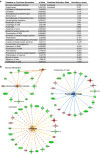Novel biomarkers of preterm brain injury from blood transcriptome in sheep model of intrauterine asphyxia
- PMID: 38822135
- PMCID: PMC11772238
- DOI: 10.1038/s41390-024-03224-1
Novel biomarkers of preterm brain injury from blood transcriptome in sheep model of intrauterine asphyxia
Abstract
Background: Infants born preterm have a higher incidence of neurological deficits. A key step in finding effective treatments is to identify biomarkers that reliably predict outcome.
Methods: Following umbilical cord occlusion (UCO) in pregnant sheep, whole fetal blood RNA was sequenced pre- and post-UCO, brain injury outcome was determined by battery of neuropathology scoring and the transcriptome signature correlated to the degree of brain injury. Additionally, we developed a novel analytical procedure to deduce cell blood composition over time.
Results: Sixty-one genes were identified with significant altered expression after UCO. In pre-UCO blood, the level of three mRNAs (Trex2, Znf280b, novel miRNA) and in post-UCO, four mRNAs (Fam184a, Angptl2, novel lincRNA and an unknown protein-coding gene) were associated to brain injury (FDR < 0.01). Several of these mRNAs are related to inflammation and angiogenesis. Pathway analysis highlighted genes playing a role in perinatal death and growth failure. Results also indicate that several leukocyte populations undergo significant changes after UCO.
Conclusion: We have used a whole transcriptomic approach to uncover novel biomarkers in fetal blood that correlate to neuropathology in the preterm sheep brain. The current data forms a basis for future studies to investigate mechanisms of these mRNAs in the injury progression.
Impact: Trend analysis of genes following asphyxia reveal a group of genes associated with perinatal death and growth failure. Several pre-asphyxia transcripts were associated to brain injury severity suggesting genomic susceptibility to injury. Several post-asphyxia transcripts were correlated to brain injury severity, thus, serve as potential novel biomarkers of injury outcome. Successfully adaptation of cell profiling algorithms suggests significant changes in blood cell composition following asphyxia.
© 2024. The Author(s).
Conflict of interest statement
Competing interests: The authors declare no competing interests.
Figures






References
-
- Serenius, F. et al. Neurodevelopmental outcomes among extremely preterm infants 6.5 years after active perinatal care in Sweden. JAMA Pediatr.170, 954–963 (2016). - PubMed
MeSH terms
Substances
LinkOut - more resources
Full Text Sources

